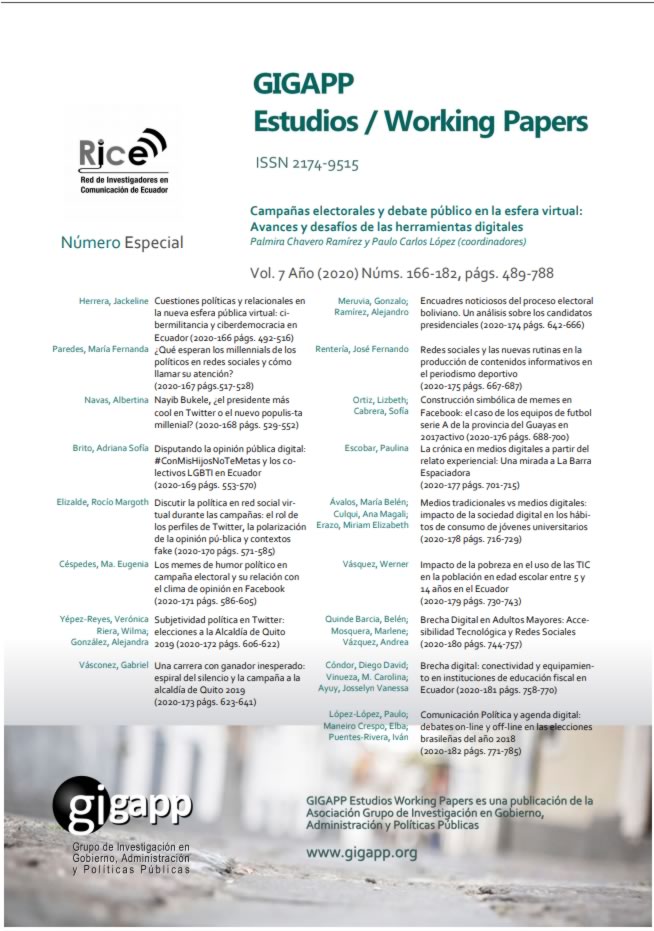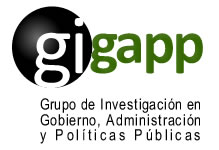Disputando la opinión pública digital: #ConMisHijosNoTeMetas y los colectivos LGBTI en Ecuador
Resumen
La esfera pública, espacio en donde se genera opinión pública, ha sufrido transformaciones con el surgimiento de Internet y las redes sociales. El objetivo del estudio es analizar la disputa de la opinión pública digital entre la campaña #ConMisHijosNoTeMetas y los colectivos LGBTI en Ecuador, desde agosto de 2017 a enero de 2018. El marco teórico se centra en las últimas perspectivas sobre el espacio público digital y sobre su posibilidad de convertirse en una esfera pública. Se utiliza una metodología mixta (cuantitativa y cualitativa), empleando como métodos el análisis de contenido, etnografía virtual y entrevista semiestructurada. Los resultados evidencian que en Internet no existe deliberación, debido a que la información en estos espacios es volátil. Además, no permite la inclusión de todos los públicos, pues Internet beneficia a unos sectores. Sin embargo, es un espacio público que permite el acceso a información y la oportunidad para sostener movimientos subversivos.
Descargas
Citas
Bacallao, P. (2016). Redes sociales, acción colectiva y elecciones: los usos de Facebook por el movimien-to estudiantil chileno durante la campaña electoral de 2013. Colombia: Universidad de la Sabana.
Fraser, N. (1997). Pensando de nuevo la opinión pública: una contribución a la crítica de las democracias existentes en Iustitia interrupta. Reflexiones críticas desde la posición postsocialista. Bogotá: Siglo del Hombre editores.
Habermas, J. (1994). Historia y crítica de la opinión pública. La transformación estructural de la vida públi-ca. Barcelona: Editorial Gustavo Gilli.
Jenkins, H. (2008). La cultura de la convergencia de los medios de comunicación. España: Ediciones Pai-dós Ibérica, S.A.
Keane, J. (1997). Transformaciones estructurales de la esfera pública en Estudios sociológicos. México: El colegio de México: Centro de Estudios Sociológicos.
Martínez, M. y Sampedro, V. (2018). The Digital Public Sphere: An Alternative and Counterhegemonic Space? The Case of Spain. Estados Unidos: International Journal of Communication.
Moreira, J. Y Sandoval, L. (2017). La horda digital. Remediatización de la esfera pública y acción política.
Papacharissi, Zizi. (2008). The Virtual Sphere 2.0: The Internet, the Public Sphere and beyond. en Hand-book of Internet Politics.
Pecourt, J. (2015). La esfera pública digital y el activismo político. Política y Sociedad.
Reguillo, R. y Robles, J. (2018). Twitter y sus perversiones: violencia y censura en Del Homo Videns al Hommo Twitter democracia y redes sociales. México: Benemérita Universidad Autónoma de Pue-bla.
Ribeiro, G. (2002). El espacio-público-virtual. Disponible en: http://repositorio.unb.br/handle/10482/18386.
Suraud, M. (2012). Vitalidad y estructuración de la opinión pública: la perspectiva de la democracia deli-berativa La opinión pública. Buenos Aires: La Crujía.
Van Dijck, J. (2013). The culture of connectivity: A critical history of social media. Estados Unidos: Oxford University Press.
Williams, R. (1996). La tecnología y la sociedad en Causas y Azares nro. 4. Extraído de Raymond Williams - Television. Technology and cultural forms - Routledge - London - 1975). Buenos Aires.
Derechos de autor 2020 Adriana Sofía Brito (Autor/a)

Esta obra está bajo licencia internacional Creative Commons Reconocimiento-NoComercial-CompartirIgual 4.0.
Aquellos autores/as que tengan publicaciones con esta revista, aceptan los términos siguientes:
a. Los autores/as conservarán sus derechos de autor y garantizarán a la revista el derecho de primera publicación de su obra, el cuál estará simultáneamente sujeto a la Licencia de reconocimiento de Creative Commons Attribution-NonCommercial-ShareAlike 4.0 International (CC BY-NC-SA 4.0) que permite a terceros compartir la obra siempre que se indique su autor y su primera publicación esta revista.
Con esta licencia de acceso abierto, los lectores (usuarios) pueden:
- Compartir — copiar y redistribuir el material en cualquier medio o formato
- Adaptar — remezclar, transformar y construir a partir del material
Bajo los siguientes términos:
-
Atribución — usarios deberán dar crédito de manera adecuada, brindar un enlace a la licencia, e indicar si se han realizado cambios. Puede hacerlo en cualquier forma razonable, pero no de forma tal que sugiera que usted o su uso tienen el apoyo de la licenciante.
-
NoComercial — usuarios no puede hacer uso del material con propósitos comerciales.
-
CompartirIgual — Si remezcla, transforma o crea a partir del material, usuarios deben distribuir su contribución bajo la misma licencia del original.
-
Sin restricciones adicionales: los usuarios no pueden aplicar términos legales o medidas tecnológicas que restrinjan legalmente a otros de hacer cualquier cosa que permita la licencia.
b. Los autores/as podrán adoptar otros acuerdos de licencia no exclusiva de distribución de la versión de la obra publicada (p. ej.: depositarla en un archivo telemático institucional o publicarla en un volumen monográfico) siempre que se indique la publicación inicial en esta revista
c. Se permite y recomienda a los autores/as difundir su obra a través de Internet (p. ej.: en archivos telemáticos institucionales o en su página web) antes y durante el proceso de envío, lo cual puede producir intercambios interesantes y aumentar las citas de la obra publicada. (Véase El efecto del acceso abierto).



